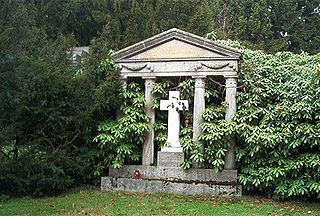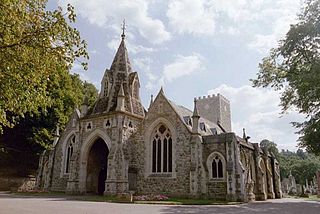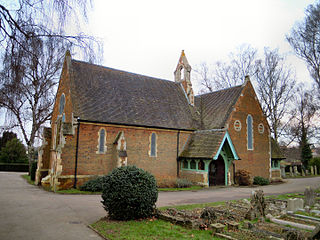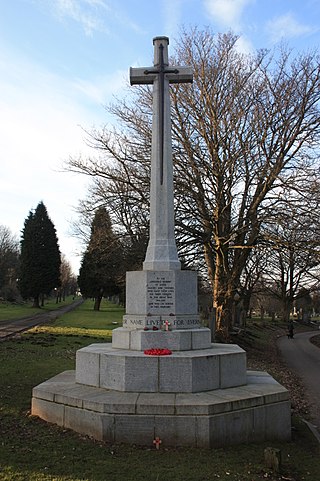
Brookwood Cemetery, also known as the London Necropolis, is a burial ground in Brookwood, Surrey, England. It is the largest cemetery in the United Kingdom and one of the largest in Europe. The cemetery is listed a Grade I site in the Register of Historic Parks and Gardens.

Cobh, known from 1849 until 1920 as Queenstown, is a seaport town on the south coast of County Cork, Ireland. With a population of 14,418 inhabitants at the 2022 census, Cobh is on the south side of Great Island in Cork Harbour and home to Ireland's only dedicated cruise terminal. Tourism in the area draws on the maritime and emigration legacy of the town.

West Norwood Cemetery is a 40-acre (16 ha) rural cemetery in West Norwood in London, England. It was also known as the South Metropolitan Cemetery. One of the first private landscaped cemeteries in London, it is one of the "Magnificent Seven" cemeteries of London, and is a site of major historical, architectural and ecological interest.

Brompton Cemetery is since 1852 the first London cemetery to be Crown property, managed by The Royal Parks, in West Brompton in the Royal Borough of Kensington and Chelsea. It is one of the Magnificent Seven cemeteries. Established by Act of Parliament and laid out in 1839, it opened in 1840. Consecrated by Charles James Blomfield, Bishop of London, in June 1840, it is one of Britain's oldest and most distinguished garden cemeteries. Some 35,000 monuments, from simple headstones to substantial mausolea, mark more than 205,000 resting places. The site includes large plots for family mausolea, and common graves where coffins are piled deep into the earth. It also has a small columbarium, and a secluded Garden of Remembrance at the northern end for cremated remains. The cemetery continues to be open for burials. It is also known as an urban haven for nature. In 2014, it was awarded a National Lottery grant to carry out essential restoration and develop a visitor centre, among other improvements. The restoration work was completed in 2018.

Saint Raymond's Cemetery is a Catholic cemetery at 2600 Lafayette Avenue in the Throggs Neck and Schuylerville sections of the Bronx, New York City, United States. The cemetery is composed of two separate locations: the older section, and the newer section, both east of the Hutchinson River Parkway. The Bronx–Whitestone Bridge is located adjacent to the cemetery's newer section, while the neighboring Throgs Neck Bridge can be seen from a distance.

Wolvercote Cemetery is a cemetery in the parish of Wolvercote and district of Cutteslowe in Oxford, England. Its main entrance is on Banbury Road and it has a side entrance in Five Mile Drive. It has a funeral chapel, public toilets and a small amount of car parking. It was awarded plaques as a category winner of 'Cemetery of the Year' in 1999 and 2001.

Dean's Grange Cemetery is situated in the suburban area of Deansgrange in Dún Laoghaire–Rathdown, County Dublin, Ireland. Since it first opened in 1865, over 150,000 people have been buried there. It is, together with Glasnevin and Mount Jerome, one of the largest cemeteries in the Dublin area, occupying 70 acres (28 ha).

The East London Cemetery and Crematorium are located in Plaistow in the London Borough of Newham. It is owned and operated by the Dignity Funeral Group.

Ohlsdorf Cemetery in the Ohlsdorf quarter of the city of Hamburg, Germany, is the biggest rural cemetery in the world and the fourth-largest cemetery in the world. Most of the people buried at the cemetery are civilians, but there is also a large number of victims of war from various nations. The cemetery notably includes the Old Hamburg Memorial Cemetery with the graves of many notable Hamburg citizens.

Putney Vale Cemetery and Crematorium in southwest London is located in Putney Vale, surrounded by Putney Heath and Wimbledon Common and Richmond Park. It is located within 47 acres (19 ha) of parkland. The cemetery was opened in 1891 and the crematorium in 1938. The cemetery was originally laid out on land which had belonged to Newlands Farm, which was established in the medieval period.

Hitchin Cemetery, also known as St John's Road Cemetery, is the main burial ground for the town of Hitchin in Hertfordshire. The cemetery is located on Hitchin Hill, with Standhill Road running along the north-western boundary and St. John's Road along the south-eastern boundary. It has been owned and managed by North Hertfordshire District Council since 1974 and has a Chapel which can accommodate about 50 mourners which is available for the burial of all faiths.

Craigton Cemetery is a cemetery in south-west Glasgow dating from the mid-19th century. It stands on Berryknowes Road.

The Western Cemetery in Dundee, Scotland, is a still-operational cemetery founded in the mid 19th century. It rises northwards from the Perth Road, with terraces in its upper sections. It views over the Firth of Tay to the Tay Rail Bridge and Fife. The Western Cemetery is maintained and managed by Dundee City Council.

The Scots Church is a former Presbyterian church in Cobh, County Cork, Ireland. It is today a museum, the Cobh Museum, which tells the history of the town.

Western Necropolis is a cemetery complex in Glasgow, Scotland located to the north of the city centre. As well as the actual Western Necropolis cemetery established in 1882, it is bordered by Lambhill Cemetery which opened in 1881, St Kentigern's Cemetery that opened in 1882, and Glasgow (Garnethill) Hebrew Burial Ground founded in 1989.

The Church of St Multose is a Church of Ireland church located in Kinsale in Ireland. It is a cruciform church with a crypt. The current structure dates from the 1190s up to major additions in the 1750s with further renovations into the twentieth century.
St. Joseph's Cemetery, Cork, was established for the burials for the poor, by temperance campaigner Father Mathew in 1830 when he leased land from the Botanical Gardens. It was sometimes called Father Mathew Cemetery. It was extended in 1880, and Fr. Mathew is buried in the cemetery. A large number of victims of the Irish Famine are buried on the site, many in unmarked graves.

The Arch Building, previously known as Cobh Town Hall and before that as Queenstown Town Hall, is a municipal building in Casement Square, Cobh, County Cork, Ireland. The building currently accommodates a public library and a tourist information centre. It is included in Cork County Council's Record of Protected Structures.


















